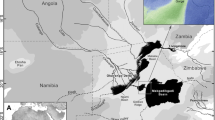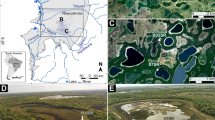Abstract
Lake Manitoba, the largest lake in the Prairie region of North America, contains a fine-grained sequence of late Pleistocene and Holocene sediment that documents a complex postglacial history. This record indicates that differential isostatic rebound and changing climate have interacted with varying drainage basin size and hydrologic budget to create significant variations in lake level and limnological conditions. During the initial depositional period in the basin, the Lake Agassiz phase (∼12–9 ka), δ18O of ostracodes ranged from −16‰ to −5‰ (PDB), implying the lake was variously dominated by cold, dilute glacial meltwater and warm to cold, slightly saline water.Candona subtriangulata, which prefers cold, dilute water, dominates the most negative δ18O intervals, when the basin was part of proglacial Lake Agassiz. At times during this early phase, the δ18O of the lake abruptly shifted to higher values; euryhaline taxa such asC. rawsoni orLimnocythere ceriotuberosa, and halobiont taxa such asL. staplini orL. sappaensis are dominant in these intervals. This positive covariance of isotope and ostracode records implies that the lake level episodically fell, isolating the Lake Manitoba basin from the main glacial lake.
δ18O values from inorganic endogenic Mg-calcite in the post-Agassiz phase of Lake Manitoba trend from −4‰ at 8 ka to −11‰ at 4.5 ka. We interpret that this trend indicates a gradually increasing influence of isotopically low (−20‰ SMOW) Paleozoic groundwater inflow, although periods of increased evaporation during this time may account for zones of less negative isotopic values. The δ18O of this inorganic calcite abruptly shifts to higher values (−6‰) after ∼4.5 ka due to the combined effects of increased evaporative enrichment in a closed basin lake and the increased contribution of isotopically high surface water inflow on the hydrologic budget. After ∼2 ka, the δ18O of the Mg-calcite fluctuates between −13‰ and −7‰, implying short-term variability in the lake's hydrologic budget, with values indicating the lake varied from outflow-dominated to evaporation-dominated. The δ13C values of Mg-calcite remain nearly constant from 8 to 4.5 ka and then trend to higher values upward in the section. This pattern suggests primary productivity in the lake was initially constant but gradually increased after 4.5 ka.
Similar content being viewed by others
References
Ashworth, A. C. & A. M. Cvancara, 1983. Paleoecology of the southern part of the lake Agassiz basin. In J. T. Teller & L. Clayton (eds.) Glacial Lake Agassiz. Geol. Assoc. Can. Spec. Paper 26: 133–156.
Buchardt, B. & P. Fritz, 1980. Environmental isotopes as environmental and climatological indicators. In P. Fritz & J. Ch. Fontes (eds.), Handbook of Environmental Isotope Geochemistry, Volume 1A: The Terrestrial Environment. Elsevier, New York: 473–504.
Colman, S. M., G. A. Jones, R. M. Forester & D. S. Foster, 1990. Holocene paleoclimatic evidence and sedimentation rates from a core in southwestern Lake Michigan. J. Paleolim. 4: 269–284.
CNC/IHD (Canadian National Committee for the International Hydrologic Decade), 1978. Hydrologic Atlas of Canada. Fisheries and Environment Canada, Ottawa, 34 pp.
Crowe, J., 1974. Lake Manitoba — the third great lake. Manitoba Dept. Mines, Resources, and Environmental Management, Information Series Number 5, 15 pp.
Delorme, L. D., 1989. Freshwater ostracodes. Geosci. Canada 16: 85–90.
Edwards, T. W. D. & P. Fritz, 1988. Stable-isotope paleoclimate records for southern Ontario, Canada: comparison of results from marl and wood. Can. J. Earth Sci. 25: 1397–1406.
Eyles, N. & H. P. Schwarcz, 1991. Stable isotope record of the last glacial cycle from lacustrine ostracodes. Geology 19: 257–260.
Fenton, M. M., S. R. Moran, J. T. Teller & L. Clayton, 1983. Quaternary stratigraphy and history in the southern part of the Lake Agassiz basin. In J. T. Teller & L. Clayton (eds.) Glacial Lake Agassiz. Geol. Assoc. Can. Spec. Paper 26: 49–74.
Forester, R. M., 1987. Late Quaternary paleoclimate record from lacustrine ostracodes. In W. F. Ruddiman & H. E. Wright (eds.), North America and Adjacent Oceans During the Last Glaciation. Geological Society of America, Decade of North American Geology, vol. K-3: 261–276.
Forester, R. M., L. D. Delorme & J. P. Bradbury, 1987. Mid-Holocene climate in northern Minnesota. Quat. Res. 28: 263–273.
International Garrison Diversion Study Board, 1976. Appendix A, Water Quality. International Joint Commission, Ottawa, 459 pp.
Last, W. M., 1982. Holocene carbonate sedimentation in Lake Manitoba, Canada. Sedimentology, 29: 691–704.
Last, W. M., 1984. Modern sedimentology and hydrology of Lake Manitoba, Canada. Environ. Geol. 5: 177–190.
Last, W. M., 1994. Paleohydrology of playas in the northern Great Plains: Perspectives from Palliser's Triangle. In M. R. Rosen (ed.), Paleoclimate and Basin Evolution of Playa Systems. Geological Society of America Special Paper 289: 69–80.
Last, W. M. & J. T. Teller, 1983. Holocene climate and hydrology of the Lake Manitoba basin. In J. T. Teller & L. Clayton (eds.) Glacial Lake Agassiz. Geol. Assoc. Can. Spec. Paper 26: 333–353.
Lister, G. S., K. Kelts, C. K. Zao, J. Q. Yu & F. Niessen, 1991. Lake Qinghai, China: closed-basin lake levels and the oxygen isotope record for ostracoda since the late Pleistocene. Palaeogeog., Palaeoclim., Palaeoecol. 84: 84–141.
Mackenzie, F. T., W. B. Bischoff, F. C. Bishop, M. Loijens, J. Schoonmaker & R. Wollast, 1983. Magnesian calcites: low-temperature occurrence, solubility and solid-solution behavior. In R. J. Reeder (ed.), Carbonates: Mineralogy and Chemistry. Mineral. Soc. Amer.: 97–144.
McCrea, J. M., 1950. On the isotope chemistry of carbonates and a paleotemperature scale. J. Chem. Phys. 18: 849–858.
McKenzie, J. A., 1985. Carbon isotopes and productivity in the lacustrine and marine environment. In W. Stumm, (ed.), Chemical Processes in Lakes, John Wiley & Sons, New York: 99–118.
McKenzie, J. A. & D. J. Hollander, 1993. Oxygen-isotope record in recent carbonate sediments from Lake Greifen, Switzerland (1975–1986): Application of continental isotopic indicator or evaluation of changes in climate and atmospheric circulation patterns. In P. K. Swart, K. C. Lohmann, J. McKenzie & S. Savin (eds.) Climate Change in Continental Isotopic Records. American Geophysical Union, Geophysical Monograph 78: 101–111.
Morse, J. W. & F. T. Mackenzie, 1990. Geochemistry of Sedimentary Carbonates. Elsevier Science Publishing Co., New York, 707 pp.
Nambudiri, E. M. V. & C. T. Shay, 1986. Late Pleistocene and Holocene pollen stratigraphy of the Lake Manitoba basin, Canada. Palaeontographica Abt. B. Bd. 202: 155–177.
Nambudiri, E. M. V., C. T. Teller & W. M. Last, 1980. Pre-Quaternary microfossils — a guide to errors in radiocarbon dating. Geology 8: 123–126.
Pearson, F. J. & T. B. Coplen, 1978. Stable isotope studies of lakes. In A. Lerman (ed.), Lakes — Chemistry, Geology, Physics, Springer-Verlag, New York: 325–340.
Rannie, W. F., L. H. Thorleifson & J. T. Teller, 1989. Holocene evolution of the Assiniboine River paleochannels and Portage la Prairie alluvial fan. Can. J. Earth Sci. 26: 1834–1841.
Ritchie, J. C., 1976. The late Quaternary vegetational history of the western interior of Canada. Can. J. Bot. 54: 1793–1818.
Schwarcz, H. P. & N. Eyles, 1991. Laurentide Ice Sheet extent inferred from stable isotopic composition (O, C) of ostracodes at Toronto, Canada. Quat. Res. 35: 305–320.
Smith, A. J., 1993. Lacustrine ostracodes as hydrochemical indicators in lakes of the north-central United States. J. Paleolim. 8: 121–134.
Talbot, M. R., 1990. A review of the palaeohydrological interpretation of carbon and oxygen isotopic ratios in primary lacustrine carbonates. Chem. Geol. (Isotope Geoscience Section) 80: 261–279.
Talbot, M. R. & K. Kelts, 1990. Paleolimnological signatures from carbon and oxygen isotopic ratios in carbonates from organic carbon-rich lacustrine sediments. In Katz, B. J. (ed.), Lacustrine Basin Exploration, AAPG Mem. 50: 99–112.
Teller, J. T., 1985. Glacial Lake Agassiz and its influence on the Great Lakes. In P. F. Karrow & P. E. Calkin, (eds.), Quaternary Evolution of the Great Lakes, Geol. Assoc. Canada Special Paper 30: 1–16.
Teller, J. T. & W. M. Last, 1979. Post glacial sedimentation and history in Lake Manitoba. Manitoba Dept. Mines, Resources, Environment Report 79–41, 182 pp.
Teller, J. T. & W. M. Last, 1981. Late Quaternary history of Lake Manitoba, Canada. Quat. Res. 16: 97–116.
Teller, J. T. & W. M. Last, 1982. Pedogenic zones in postglacial sediment of Lake Manitoba, Canada. Earth Surf. Proc. Landforms, 7: 367–397.
Teller, J. T. & W. M. Last, 1990. Paleohydrological indicators in playas and salt lakes, with examples from Australia, South West Africa, and Canada. Palaeogeogr., Palaeoclimatol., Palaeoecol. 76: 215–240.
Teller, J. T. & H. Thorleifson, 1983. The Lake Agassiz-Lake Superior connection. In J. T. Teller & L. Clayton (eds.) Glacial Lake Agassiz. Geol. Assoc. Can. Spec. Paper 26: 261–290.
Turner, J. V., P. Fritz, P. F. Karrow, & B. G. Warner, 1983. Isotopic and geochemical composition of marl lake waters and implications for radiocarbon dating of marl lake sediments. Can. J. Earth Sci. 20: 599–615.
Vance, R. E. & W. M. Last, 1994. Paleolimnology and global change on the southern Canadian prairies. In Geological Survey of Canada; Current Research 1994-B: 49–58.
Van Stempvoort, D. R., T. W. D. Edwards, M. S. Evans & W. M. Last, 1993. Paleohydrology and paleoclimate records in a saline prairie lake core: mineral, isotope and organic indicators. J. Paleolim. 8: 135–147.
Author information
Authors and Affiliations
Additional information
This is the sixth in a series of papers published in this issue on the paleolimnology of arid regions. These papers were presented at the Sixth International Palaeolimnology Symposium held 19–21 April, 1993 at the Australian National University, Canberra, Australia. Dr A. R. Chivas served as guest editor for these papers.
Rights and permissions
About this article
Cite this article
Last, W.M., Teller, J.T. & Forester, R.M. Paleohydrology and paleochemistry of Lake Manitoba, Canada: the isotope and ostracode records. J Paleolimnol 12, 269–282 (1994). https://doi.org/10.1007/BF00678025
Received:
Accepted:
Issue Date:
DOI: https://doi.org/10.1007/BF00678025




